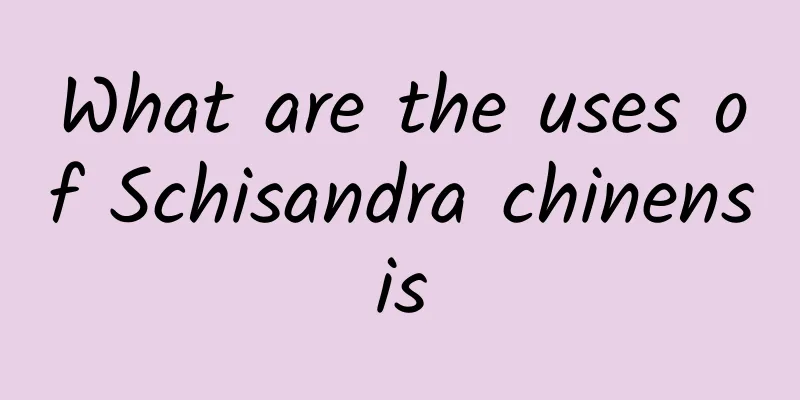What are the uses of Schisandra chinensis

|
Nowadays, many people have seen Chinese medicine, because our living standards are constantly improving, but our quality of life is constantly declining. When our quality of life declines, we cannot bring health to our bodies, and our bodies are harmed step by step. Therefore, many people who take medicine frequently know about Schisandra chinensis, but many people do not know the basic uses of Schisandra chinensis. They only know that their medicines contain Schisandra chinensis. So what are the uses of Schisandra chinensis? As a medicinal material, Schisandra chinensis was first recorded in "Shennong's Herbal Classic" and listed as a top-grade product. The ancients once commented on Schisandra chinensis like this: "Schisandra chinensis has sweet and sour skin and flesh, bitter and acrid nucleus, and salty taste, which means it has all five flavors." Perhaps this is the origin of its name, Schisandra chinensis is a Chinese name for the Wen surname. Modern pharmacological research shows that Schisandra chinensis contains a variety of nutrients, such as schisandra, malic acid, citric acid, tartaric acid, succinic acid, fatty oil, volatile oil, sugars, resin, vitamin C, etc., as well as trace elements such as tungsten, iron, manganese, zinc, and phosphorus. It is commonly used in clinical practice to treat neurological and cardiovascular diseases. Schisandra chinensis can enhance the excitation and inhibition process of the central nervous system and make it tend to balance, thereby improving the body's activity function, reducing and relieving fatigue, and improving the quality of life and work efficiency; it can regulate the cardiovascular system by strengthening the heart's contractile force function, thereby improving blood circulation and lowering blood pressure; Schisandra chinensis has a stimulating respiratory effect, improves lung function, and has a significant cough and expectorant effect; it can also regulate gastric juice secretion and excite the uterus; it has a protective effect on the liver. Schisandra chinensis is the main component for lowering GPT. Generally, GPT begins to decrease after one week of medication. It is an ideal drug for the treatment of liver and gallbladder diseases. In addition, Schisandra chinensis has a certain effect in inhibiting the reproduction of bacteria and other pathogenic microorganisms. The water decoction of Schisandra chinensis has a strong inhibitory effect on Mycobacterium tuberculosis, Bacillus subtilis, Escherichia coli, Salmonella typhi, Staphylococcus aureus, Streptococcus, and Pneumococcus. In clinical practice, its astringent effect is used to strengthen the lungs, stop sweating, astringe semen and stop diarrhea. Schisandra chinensis has many uses. When taking Schisandra chinensis for yourself, you must consider the situation, because not all diseases can be treated with Schisandra chinensis. Schisandra chinensis must be combined with other medicines so that the medicine can be more perfect and the therapeutic effect on the disease will be more prominent. If you use Schisandra chinensis, you must pay attention to the precautions for taking it and avoid taking too much. |
<<: What are the side effects of Curculigo?
>>: Can fresh dendrobium be eaten directly?
Recommend
There are obviously not many cars and no accidents, so why is there a traffic jam?
Audit expert: Zhu Guangsi Member of Beijing Scien...
What would happen to humanity if the Earth lost its atmosphere?
Generally speaking, the less noticeable something...
The efficacy and function of Shilongchu root
The medicinal value of stonewort root is beyond o...
The efficacy and function of geranium
As a traditional Chinese medicine, Jiaxiang has g...
The "Quiet Night Thoughts" you recited was never seen by Li Bai
Recently, the movie "30,000 Miles from Chang...
The efficacy and function of round-petaled cold water flower
Many people are not very clear about the round-pe...
What are the effects and functions of Zhengshan Xiaozhong
my country's tea culture has a long history, ...
Beware! 5 common risks in the home, the last one many people don’t know about!
The winter vacation is coming soon, and the child...
The fruits in supermarkets are generally good-looking! Is it because they have been added with something "active"?
When you visit the fruit section of a supermarket...
How many surprises are there in the southernmost part of Yunnan?
In the south of the colorful clouds , the Yunnan ...
The "magic medicine" that can eliminate rheumatism and strengthen bones and muscles grows in your backyard
I went back to my hometown some time ago and saw ...
The efficacy and function of Tibetan Artemisia
In daily life, people are not only very familiar ...
Quantum of the Tomorrow: The most awesome photo ever
In the Southern Song Dynasty, during the Battle o...
The efficacy and function of red snow lotus
In daily life, we can often see red flower snow l...
Shenling Baizhu San
Shenling Baizhu Powder is made from a variety of ...









